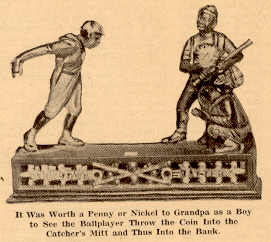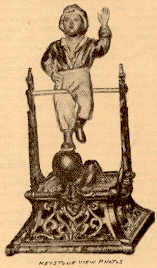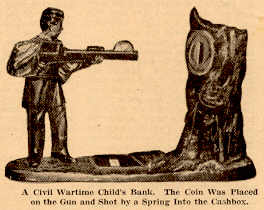|
AMERICAN WEEKLY, 1936
Gadgets That Helped Grandpa
Start Making His Fortune
WHEN grandpa was a boy, politicians
hadn't yet got around to promising an old-age pension to anybody who
manages to keep body and soul together long enough to claim it. In his
youth he was told that if he didn't look out for his own future by
saving his money he was liable to wind up over the hill in the
poorhouse. But he liked striped stick candy as much as the children
nowadays like all-day- suckers. So if his folks were thrifty they
probably bought him one of these amazing gadgets to teach him that a
penny saved is a penny earned.
 
Putting money in an ordinary
toy bank is no fun to a child who would rather spend it. But when a coin
is inserted into these contrivances they promptly go through their
diverting gyrations and saving becomes a pleasure. The four shown here
belong to the collection made by Mr. Elmer R. Jacobs, comptroller of the
Seamen's Bank for Savings of New York City, and most amusing is perhaps
the baseball group.
 The penny is put into the back-stretched hand of the pitcher, who is all
poised to send a "fast one" over the home plate. Even though
he makes an underhand throw, like a girl, he never fails to fool the
batter, who swings too late, just as the coin clinks into the mitt of
the stooping catcher, and goes rattling through the slot, down into a
compartment, where it is quite safe from prying hairpins or shingle.
nails.
The penny is put into the back-stretched hand of the pitcher, who is all
poised to send a "fast one" over the home plate. Even though
he makes an underhand throw, like a girl, he never fails to fool the
batter, who swings too late, just as the coin clinks into the mitt of
the stooping catcher, and goes rattling through the slot, down into a
compartment, where it is quite safe from prying hairpins or shingle.
nails.
Then there is the "daring young man on the
flying trapeze," or maybe it is just a horizontal bar. At any rate,
a penny is too much of a burden for him to hang on to very long, and
when he has one in his hand he just can't keep still. But he doesn't run
the risk of burning a hole in his pocket by trying to save it that way.
Instead, he promptly flips over and sticks it into the slot.
When Johnny came marching home again, after the
war between the States, whether he wore blue or gray, he doubtless soon
learned that nothing gives a man such a comfortable feeling as money in
the bank. One way he taught this lesson to his sons was with the
sharp-shooting soldier. A penny in the barrel of the castiron soldier's
gun is fired into the tree stump. A bell rings, the gunner expresses his
satisfaction by snapping his head to one side, and the coin plinks into
the cashbox.
 The American eagle on the figure to the right not only guards the hoard
in this bank, but when it bends over with a coin in its beak, flapping
its wings, the eaglets rise up as the money drops into the nest,
expressing their delight by whistling.
The American eagle on the figure to the right not only guards the hoard
in this bank, but when it bends over with a coin in its beak, flapping
its wings, the eaglets rise up as the money drops into the nest,
expressing their delight by whistling.
This patriotic idea for a penny bank may have
been inspired by the old joke about squeezing a coin until the eagle
screamed, but just the same this type was one of the most popular. Once
the eagle got a penny in its beak it held on until the coin was safely
deposited in the slot. The screaming in this case was the shrill piping
of the thrifty little eaglets.
A boy who owned one of these amusing banks was
doubtless much better able to resist temptation than one who didn't. The
red and white-striped peppermint candy or lemon drops in the tall jars
at the corner drugstore might be ever so luring. And he might yearn for
one of those "frog-sticker" jack-knives, which had blades that
would on scarcely cut anything harder than warm butter, but were mighty
attractive, with their polished bone handles and their glittering nickel
chains, that could be hooked to a pants' button.
But if he had one of these banks at home,
whenever he found a penny, earned one, or was given one, the moral
struggle against the inclination to squander his wealth was certainly
much less severe.
Modern psychologists say that the lessons which
make the most lasting impression on children are those they enjoy
learning. This being so, the idea of rewarding thrift by making it fun
to put pennies in the bank was certainly a good one, and whoever first
thought of it must have had a good understanding of child psychology. If
there was anything wrong with the idea it was probably that it worked
too well — it may have caused children to clamor too much for pennies,
so they could see the little figures do their stunts.
In fact, there are probably a number of
substantial business men today sitting behind batteries of telephones on
mahogany desks, and other gentlemen pleasantly engaged in clipping
gilt-edge coupons, who will recall how they used to plague the life of
their elders for odd jobs that would bring in the coins needed to make
these diverting gadgets click and whir.
|



 The penny is put into the back-stretched hand of the pitcher, who is all
poised to send a "fast one" over the home plate. Even though
he makes an underhand throw, like a girl, he never fails to fool the
batter, who swings too late, just as the coin clinks into the mitt of
the stooping catcher, and goes rattling through the slot, down into a
compartment, where it is quite safe from prying hairpins or shingle.
nails.
The penny is put into the back-stretched hand of the pitcher, who is all
poised to send a "fast one" over the home plate. Even though
he makes an underhand throw, like a girl, he never fails to fool the
batter, who swings too late, just as the coin clinks into the mitt of
the stooping catcher, and goes rattling through the slot, down into a
compartment, where it is quite safe from prying hairpins or shingle.
nails. The American eagle on the figure to the right not only guards the hoard
in this bank, but when it bends over with a coin in its beak, flapping
its wings, the eaglets rise up as the money drops into the nest,
expressing their delight by whistling.
The American eagle on the figure to the right not only guards the hoard
in this bank, but when it bends over with a coin in its beak, flapping
its wings, the eaglets rise up as the money drops into the nest,
expressing their delight by whistling.